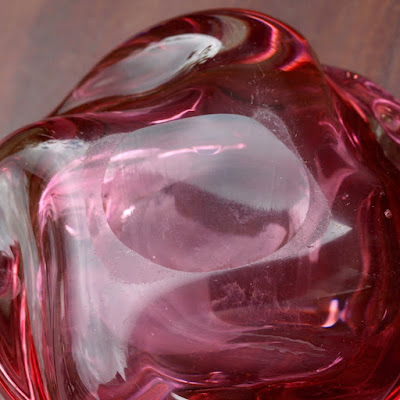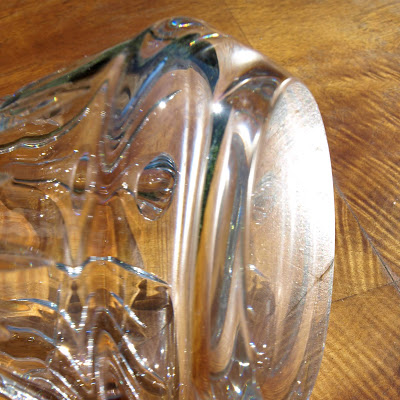FREE SHIPPING ON ALL ITEMS AT FAB FINGS
How to tell if your piece of glass is old or not.
You might have noticed me often showing a shot of the base of glassware, be it a vase, bowl or glass. That's because the base of many glassware pieces can provide indications to age and method of manufacture. When sourcing stock for Fab Fings, we always turn things over to find out if they've been handmade or mass produced, and to get an idea of when they were made. Aging and valuing antiques and vintage items is often carried out after studying all the indicators.
The piece above is a 60s glass jug. The base shows a ground down pontil mark: it's the small round crater in the middle. This proves one thing: it was handmade. The pontil mark is now missing as it's been ground out but if it was still there it would be a sharp and jagged area left over from when the glassblower snapped the jug off his rod of glass. To avoid cut fingers and scratched tables, the pontil mark was ground down. Now, it is possible to get recently made handmade glassware with this ground down pontil mark, so how do we know the piece above is vintage and not brand new? We look for other indicators, just like a detective would solve a crime.
Another thing to look for on the base to back up the pontil mark is wear. A recently made item of glassware will not have many scratches on the base. It takes decades of use to cause scratches on the base of glassware. The jug above has some scratches on the base and, coupled with the fact the styling of the jug is in keeping with the 60s style, this jug was aged accordingly. However, it didn't have a huge amount of scratches as it was not that old and probably not used a great deal, instead kept on display in a cupboard.

The piece of glass above is old...about 70s years old! It's an ashtray from the 50s and has a ground out pontil mark and lots of fine scratches around the circle, these scratches being caused by decades of being moved on tables, shelves, counter-tops, etc.

Another thing to look for on the base to back up the pontil mark is wear. A recently made item of glassware will not have many scratches on the base. It takes decades of use to cause scratches on the base of glassware. The jug above has some scratches on the base and, coupled with the fact the styling of the jug is in keeping with the 60s style, this jug was aged accordingly. However, it didn't have a huge amount of scratches as it was not that old and probably not used a great deal, instead kept on display in a cupboard.

The piece of glass above is old...about 70s years old! It's an ashtray from the 50s and has a ground out pontil mark and lots of fine scratches around the circle, these scratches being caused by decades of being moved on tables, shelves, counter-tops, etc.

The piece above also has a ground down pontil mark and has more scratches around the outside of the base, where you would expect decades of wear to show. This jug has more scratches than the first jug and that fits with the style of the jug, which is 50s.
The image above is of a vintage Mdina vase. The base is small and the glassblower has ground all of it to remove the pontil mark and create a perfectly flat surface for stability for this very spherical piece. You can see lots of age related scratches to the base of this vase, which dates to around the 50s.

This clear glass jug is different as it has very few scratches on the base. Antiques and vintage items don't always come with cast iron rules on how to date them. Sometimes, anomalies occur and decades of experience in the antique and vintage world can help solve the riddles. This piece, which is around a hundred years old, has survived unscathed on its bottom because it's probably never been used. A lot of 'special' pieces of glassware have been kept locked away in a cabinet 'for best' and never been brought out for fear of breakage. So this beautiful piece of English glassware has survived in perfect condition thanks to such delicate treatment. My advice, however, it to use these lovely things on a daily basis and get pleasure out of them every time you do, which is probably what the makers intended.
The image above is of another piece of clear antique glassware, this time with a huge amount of wear on the base, along with a ground down pontil mark. So we know it was handmade and it's very very old. We also know it was used a lot! The sides of this wine carafe are also heavily nibbled. So, not only was it dragged about on tables a lot, maybe even on stone floors, but it was also clanged about against other items of glassware and ceramics, maybe hurriedly washed in an old Belfast sink....many times a day. Yes! This is a two hundred year old pub carafe! It was made of very thick glass because it was going to suffer at the hands of drunk people and the hands of rushed pot washers. It has so much age related wear because it was manhandled by drunks. So this piece of antique glassware would be expected to have a lot of wear as it certainly was not kept locked away for fear of breaking but was very much a part of the party. This was made to be a working item not a showpiece.
The glassware above is a vintage Mdina paperweight. It has a ground off base with age-related scratches. It's not as battered as the carafe above as this is an ornament and therefore not moved very often. Modern paperweights tend to have a misty looking base.
Above is a vintage Austrian artglass bowl. It has a very flat bottom with a ground out pontil mark.
More authentic age-related scratches to the base of this Whitefriars Hambone vase.
The vintage glass jug above is has age related scratches to the bottom rim and also a ground out pontil mark.
The image above shows the base of a vintage Murano dolphin ornament with lots of age related scratches.
So, the moral of this story is to always turn a piece over to study the bottom but to also consider the life of the piece and whether or not it should be expected to be rough around the edges or as perfect as the day it was made. There are many other indicators of age and manufacturing process but the bottom tends to reveal the most. But age isn't everything. Has it lived or barely existed, preserved in a cabinet so it can live at a later date? What stories could it tell?
There are a few other ways to tell if your piece of glass is old or not. Here are a few tips:
- Check the color. Old glass is often a different color than modern glass. For example, old green glass may be a lighter shade of green than modern green glass.
- Examine the seams. Old glass is often made with hand-blown glass, which means that the seams will be visible. Modern glass is typically machine-made, so the seams will be less visible. Seams will come from the glass blower attaching different parts together or from the factory attaching pressed parts together.
- Look for markings or labels. Old glass may have markings or labels that can help you identify the manufacturer or the age of the glass. This is more likely with retro glassware.
See what glassware is for sale at Fab Fings.
Display prices in:GBP
